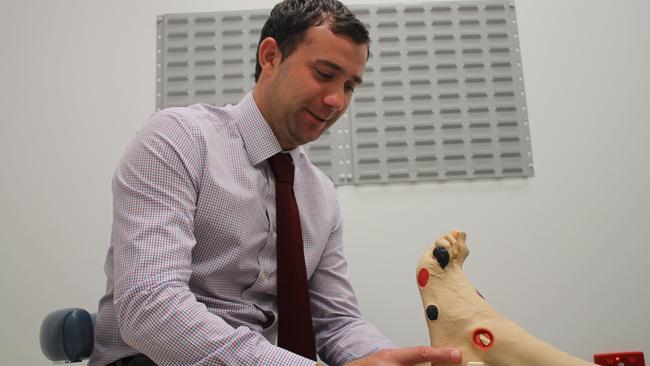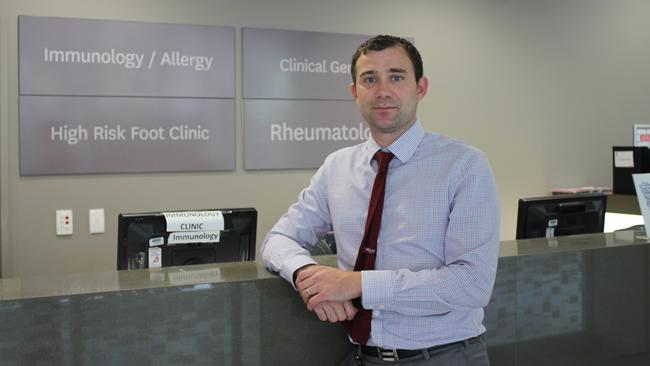Specialists race to develop new ways to treat diabetic patients as rates grow
A world first clinical trial is underway in Liverpool aimed at halting a modern scourge — the spiralling number of foot and leg amputations caused by diabetes.

Southwest
Don't miss out on the headlines from Southwest. Followed categories will be added to My News.
- Pensioners ‘kept in the dark’ about cheap hospital parking
- The woman who cheated death nine times
- Shot or stabbed then “dumped” at hospital
- Arabic version of CPR course to save lives
A world first clinical trial is underway in Liverpool aimed at halting a modern scourge — the spiralling number of foot and leg amputations caused by diabetes.
Up to 200 amputations of feet, legs and toes were performed at Liverpool Hospital in 2015, confirming an alarming health trend showing southwestern Sydney is the diabetes capital of NSW.
Leading the charge to turn the numbers around is Liverpool Hospital podiatric medicine department head Matt Malone and the research team at Ingham Institute’s Liverpool Diabetes Collaborative Research Unit.
They are in the midst of a world-first clinical trial of the drug denosumab to treat charcot foot, a condition that causes the weakening of the bones in the foot.
It is a flow-on effect of diabetic foot disease. At present, denosumab is successfully used to treat hip fractures.


But aside from their highly specialised work, Mr Malone says little money has been allocated to combat diabetic foot disease, a serious complication that is the number one cause of hospital admission for patients and sufferers.
“When you look at funding, over the last five years, there has been none for diabetes foot research,” he said.
Diabetes is rife in Sydney’s south west, with 11 per cent of the population diagnosed with diabetes, the highest in the state. By 2030, the number of Aussies with Type 2 diabetes is expected to rise to 3.3 million.
Prime Minister Malcolm Turnbull did touch on the issue at the weekend when he pledged $54 million for new technology to constantly monitor Type 1 patients’ blood sugar and transmit the results to a smartphone or insulin pump, if re-elected. The $54 million will subsidise the cost of devices for some 4000 young people.
But the toll on limbs taken by Type 2 disease — which is largely caused by lifestyle factors and afflicts more people each year — continues to mount.
More than 90 per cent of all cases at Liverpool Hospital’s high risk foot clinic are diabetic patients.
“We see 150 to 400 patients a month and 90 per cent are diabetes-related,” Mr Malone said.

“More often than not it (a wound) leads to amputation ... there is a diabetes-related lower extremity amputation occurring every 20 seconds worldwide.
“A lot is preventable, but the lack of regular involvement in primary care is a problem.”
He said up to 85 per cent of diabetic foot complications were preventable. He emphasised the importance of research funding and people getting primary care sooner.
“The problem is, people aren’t coming in for treatment until their foot is dropping off. We need help from GPs to see people earlier.”
Mr Malone said he could fill a ward for six months just for patients with diabetes-related foot problems.
“Everything from ulcers to foot infection to amputations. One in four people diagnosed with diabetes will develop foot problems — from small wounds to infection, up to amputation,” he said. “We spent $8.5 million over 18 months in 2013 and 2014 on surgeries (amputations) and managing care and the cost of diabetic patients staying in hospital.”
Mr Malone said the advantage of having such a strong research team in Sydney’s south west meant its residents benefited.
Amputees now in their 30s
After stepping on barnacles at the beach, Cecil Hills’ Lidija Simunovic had one of her toes amputated.
The cut resulted in bacteria spreading and infection.
Having type 1 diabetes affected her healing, resulting in the amputation.
It was her second operation, having lost another toe in 2009.
“I was scared. I was angry at myself. A whole mix of emotions,” the 33-year-old said after losing two toes.
The age of a diabetic patient presenting at Liverpool Hospital’s high risk foot clinic with infection or serious wounds is getting younger and younger.
Liverpool Hospital podiatric medicine department head Matt Malone said they used to be in their 60s and 70s.
“That has changed drastically — they’re getting younger and younger,” he said.
“We’re amputating on people in their 40s and 50s and even some in their 30s. This is reflective of the prevalent increase in type 1 diabetes in children.”
Ms Simunovic attends the high-risk foot clinic once a week and while it hasn’t affected her ability to lead a normal life, her confidence has taken a beating.
Her advice to others with diabetes — do all the right things so you don’t end up with complications with your feet and heart.
“Don’t be put off by all the different doctors and specialists you have to see,” she said.
Failure to have health checks increases risks
Putting off your health checks could be increasing your risk of developing irremediable conditions, according to one of Australia’s leading doctors.
Chris Qureshi, a surgeon at PersonalEYES, is concerned about the high number of Liverpool residents putting off personal health check-ups.

He said there were two types of people delaying their checks — those who get caught up in their busy lifestyle and don’t prioritise time for it and those who are afraid of what results might reveal.
“Prevention is the best cure for many diseases and conditions, and once you’ve had a check up, in most cases you don’t need to worry about them for another year or more,” Dr Qureshi said.
Dr Qureshi completed his first four years of training at Liverpool Hospital, so understands the problems locally, particularly with diabetes.
“A lot of the time, particularly younger patients, don’t even know they have the disease. That’s why we’re stressing early detection,” he said.
“If it’s detected earlier, we could have made a small course correction and saved the heartache and a lot of distress later in life.”
Dr Qureshi said if 50 per cent of his patients were seen earlier, they could have prevented a lot of treatment down the track.
“Having a good GP is important — they can check your skin, order blood tests, check your blood pressure and cholesterol.”
He said even simple things like eating healthy food, cutting down on sugar, regular exercise and good sleeping patterns, helped form a good patient.
“If you’re not doing these things, you’re going down a slippery slope to poor health,” he said.
“While your eyes are the window to your soul, they are also the window to other diseases. I can identify things specifically in the lens and see markers on the retina and blood vessels — it’s quite obvious if there's something there.”
He said patients would be “making a small contribution now, but saving thousands of dollars later in your life”.


